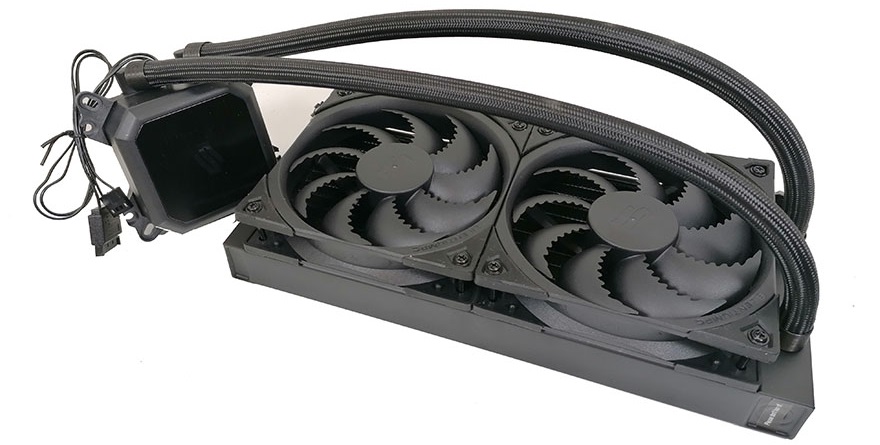SilentiumPC Navis F240 AIO Liquid Cooler Review
Mike Sanders / 2 years ago
A Closer Look
We have a bit of an unusual set of circumstances here as the SilentiumPC Navis F240 is, pretty much, ready to go right out of the box. In fact, to show some details to the specific components, I’ve actually (something frustratingly from purely a review aspect) had to actually disassemble some parts here. – On the whole, though, having it ready to go (pending the mounting bracket to the motherboard) is certainly a nice and highly unusual consideration.
What about those individual components though? Well, let’s take a closer look!

CPU Water Block
While not specifying any particular manufacturer, the water block is well presented with a sleek black aesthetic with a brushed-metal effect surface to the top. It’s a surprisingly slim design and comes with pre-fitted mounting points for all major Intel and AMD sockets. Nope, there’s nothing to remove or alter here prior to installation!

With the SilentiumPC logo in the centre, based on the image below you might think that this looks rather nice embossed into the surface. The truth, however, is that you really do have to capture it from a certain angle for it to stand out. It’s a little too understated for its own good and lacking any direct light source, it’s barely visible at all.
I see what SilentiumPC was going for here in terms of a subtle aesthetic touch, but ultimately it doesn’t work. From most angles, it just blends in.
One minor aesthetic grumble I could have is the fact that with it having pre-installed compatibility for all supported sockets, those that aren’t going to get utilised might look a little messy when installed. I think though that I’m happier to have the trade-off in what will be a notably easier installation at the slight cost of a slightly less clean aesthetic.

Contact Plate
The contact plate is nice and large and as can be seen below, has been designed in a slightly elongated shape. Although not specifically listed, we suspect that this has been done to provide better overall coverage for Alder Lake processors which have a more horizontal shape when compared to prior Intel processors (and, of course, AMD Ryzen). In regards to AMD, although no specific AM5 compatibility has been confirmed (yet), given that the Ryzen 7000 series is also expected to take a similarly shaped design to Alder Lake, it does seem that this cooler will almost certainly offer solid levels of not just CPU coverage, but compatibility for either Intel (Alder Lake and the upcoming Raptor Lake) or AMD Ryzen 7000 processor models!

Radiator
It’s a radiator… Yep, that’s pretty much all I have to say about it. Ok, I can elaborate a little further if you’d like, but I warn you, I’m only telling you what you probably already know. It’s a 240mm design, it carries no aesthetic touches or branding, and looks pretty much identical to any other 240mm AIO liquid cooler radiator.
I’d call it boring, but truth be told, the vast majority of manufacturers seem to think that there’s very little to be done with radiators to make them interesting.
In regards to its functionality though, keep reading as I do have a number of points to raise about this in the installation aspect of this review!

Fans
Given that this is a 240mm AIO liquid cooler, it should (hopefully) come as no surprise to learn that you are supplied with 2 x 120mm cooling fans. While clearly lacking the lighting components of its ARGB counterpart, SilentiumPC’s own Fluctus 120 PWM fans still carry a very eye-catching aesthetic and especially so in regards to the blade edges.

Coming with nice thick rubber padding to each corner, all going well these should provide strong levels of airflow while keeping any vibratory noises to an absolute minimum. The good news for you is that these come pre-installed on the radiator right out of the box. The bad news for me is that I’ve now got to reattach them before I can get to test it!

Overall
In terms of design, on the surface, the SilentiumPC Navis F240 looks to be an excellent AIO liquid cooler. Admittedly, the aesthetics are somewhat limited due to the lack of any ARGB lighting effects, but in truth, with such a variant there if you want it, keeping a more understated model like this is probably an exceptionally wise move.
ARGB is divisive, whereas this wouldn’t look out of place within any kind of system. – Before we find out though if the looks match the performance, let’s get this installed first and see how that works out!




















